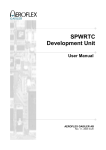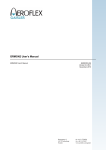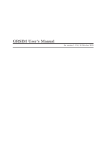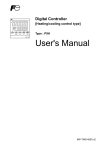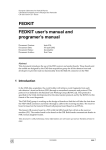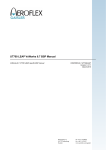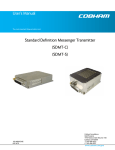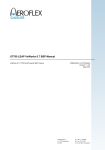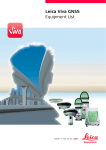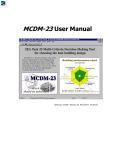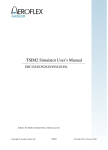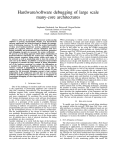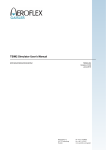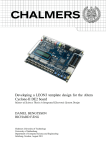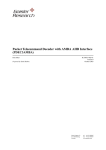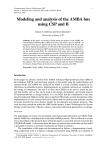Download grlib-an-0004
Transcript
Handling of External Memory EDAC Errors in LEON/GRLIB Systems
Application note
Doc. No GRLIB-AN-0004
Template: GQMS-TPLT-1-1-0
Issue 1.0
2015-10-28
Doc. No:
GRLIB-AN-0004
Issue:
1
Rev.:
Date:
2015-10-28
Page:
0
2 of 11
CHANGE RECORD
Issue
Date
1.0
2015-10-28
Section / Page
Description
First issue.
TABLE OF CONTENTS
1
1.1
INTRODUCTION............................................................................................................. 3
Scope of the Document......................................................................................................3
2
SYSTEM LEVEL BACKGROUND.................................................................................3
3
3.1
3.2
3.3
3.4
SCRUBBING EXTERNAL MEMORY............................................................................4
Introduction....................................................................................................................... 4
Baseline software approach............................................................................................... 4
Hardware offloaded scrubbing.......................................................................................... 5
Additional considerations.................................................................................................. 5
4
4.1
4.2
4.3
4.4
HANDLING UNCORRECTABLE ERRORS.................................................................. 5
Background........................................................................................................................5
LEON Processor Behaviour on Uncorrectable Errors.......................................................6
Data Trap Handler............................................................................................................. 7
Additional considerations.................................................................................................. 9
© Cobham Gaisler AB
Doc. No:
GRLIB-AN-0004
Issue:
1
Rev.:
Date:
2015-10-28
Page:
0
3 of 11
1
INTRODUCTION
1.1
Scope of the Document
This document contains general notes on handling correctable and uncorrectable errors in
LEON/GRLIB system-on-chip devices.
2
SYSTEM LEVEL BACKGROUND
Note that system level design and radiation effects analysis is outside the scope of IP core and
component support. This section is only intended to provide a background to clarify the design
intent of the IP cores.
The approach that is assumed in the LEON3FT and LEON4FT designs and components for use in
space applications is that the system designer designs the system so that correctable (single-bit in
the case of BCH EDAC or single-nibble in case of Reed-Solomon codes) errors in memory happen
at a controlled rate (probability per time unit) and uncorrectablet errors happen at a very low rate
below the acceptable failure rate for the system so that the EDAC does not need to cover it.
If the system is designed to give such guarantees, the EDAC in the LEON3FT system's memory
controller is then used to execute correctly despite the correctable errors that occur, and scrubbing
in software or in hardware can be designed on top of that to prevent building up multiple single-bit
errors over time to a double error.
There will always be a remaining failure rate caused by the risk of multi-bit errors and multiple
correctable errors accumulating to uncorrectable errors faster than the scrubbing can repair them. It
is the system designer's responsibility to do the necessary analyses to calculate the residual failure
rate and decide what is acceptable for the mission.
In most cases, the system designer also adds a watchdog timer as a general safety net that resets the
system in case of a crash. This can be due to multi bit error but also due to if there is a software bug
that gets missed in validation or a hardware problem such as input clock glitch or power supply
glitch.
In most designs it's preferred to fail immediately when getting double-bit errors since you can not
guarantee that execution will continue correctly, you want to avoid incorrect behavior (for example
sending bad messages to other systems) and you want to reboot to get to a known good state as fast
as possible.
© Cobham Gaisler AB
Doc. No:
GRLIB-AN-0004
Issue:
1
Rev.:
Date:
2015-10-28
Page:
0
4 of 11
3
SCRUBBING EXTERNAL MEMORY
3.1
Introduction
The design used in LEON3FT systems such as UT699, UT699E, UT700, LEON3-RTAX and
GR712RC is as follows:
3.2
•
When a memory controller with EDAC enabled (such as FTMCTRL) detects a correctable
error, the data will be temporarily corrected and delivered onto the on-chip bus. However a
sideband signal will be asserted at the same time to indicate that a read access has been
corrected.
•
This sideband signal is connected to the AHB status register, and will cause it to copy in the
address of the access into the address register, set the New error (NE) and correctable error
(CE) bits, and raise an interrupt. The AHB status register is typically assigned to IRQ line #1
on systems designed by Cobham Gaisler, including the UT699 - UT700 and GR712.
Baseline software approach
A general software approach would then be to add a handler for IRQ 1, that checks the AHB status
register and performs the appropriate action such as scrubbing the location by reading and writing it
back, and then clear the AHB status register so it can latch in new errors.
To avoid cache effects on data load, one can use the load instruction with forced cache miss (LDA
with ASI=1). The LEON3FT's cache is write through, therefore write accesses will not be affected
by cache effects.
To make sure all data gets scrubbed regularly is is possible to have a background task with an
address counter that reads through a bit of memory once in a while. This can just read and discard
the data, since the IRQ handler above will take care of the actual scrubbing when needed.
Note that the AHB status register can only remember one error, so any correctable errors occurring
before the current one has been handled (and the NE/CE bits have been cleared) will be temporarily
corrected on the fly as usual but the correction will not be registered by the AHB status register and
therefore not be corrected by the scrubbing scheme routine. Once the AHB status register is idle and
someone reads again from this location, the correctable error will be discovered and handled.
DMA will complicate the issue, as the read/write sequence in the IRQ handler may get into a "race"
with a DMA master writing to that same location. One will have to do some analysis to see if this
can happen in the specific setup. Note that many times memory accessed via DMA will just be
read/written once so that fact can be used in the analysis (for example you may find that areas
accessed by DMA never need scrubbing).
© Cobham Gaisler AB
Doc. No:
GRLIB-AN-0004
Issue:
1
Rev.:
Date:
2015-10-28
Page:
3.3
0
5 of 11
Hardware offloaded scrubbing
Newer systems, such as the GR740 device or other devices that include the MEMSCRUB
peripheral from Cobham Gaisler have a hardware memory scrubber. The MEMSCRUB IP cores
provides periodic scrubbing of external memory. It uses a generic approach compatible with any
memory controller with AHB interface and EDAC, designed in the way described in section 3.1.
When the scrubber finds a correctable error, it will used a locked read/write cycle to perform the
scrub operation, thus avoiding any possible race with DMA units or other masters.
The MEMSCRUB also includes all the AHB status register functionality and has a backward
compatible software interface, therefore it can also be also be used with existing software scrubbing
routines.
For more information on MEMSCRUB, please see the GRLIB IP Core User's Manual.
3.4
Additional considerations
In addition to the general notes in the previous section, the following items should be considered:
•
•
•
In systems with a memory protection unit it may be required to check that the memory is
writable.
For uncorrectable errors (ERROR responses), software needs to check that the memory
address is on the memory controller. The AHB (bus) controller in GRLIB replies with
ERROR if an unmapped memory area is accessed.
Always check that correctable error is in RAM before trying to correct
4
HANDLING UNCORRECTABLE ERRORS
4.1
Background
LEON/GRLIB systems such as UT699, UT699E, UT700, LEON3-RTAX, GR712RC and GR740
have the option to protect memory areas with error detection and correction (EDAC). When EDAC
corrects an error in memory then a side-band signal will be raised and software will typically be
notified about this through the AHB status register. How to use this functionality to implement
memory scrubbing in order to prevent build up of errors is described in section 3 of this document.
When a memory controller detects an uncorrectable error it will respond with an AMBA ERROR
response. An AMBA ERROR response will have the following effects:
•
If the design has an AHB status register (present in all Cobham Gaisler LEON ASIC
devices) then the error response will cause it to copy in the address of the access into the
© Cobham Gaisler AB
Doc. No:
GRLIB-AN-0004
Issue:
1
Rev.:
Date:
2015-10-28
Page:
•
•
0
6 of 11
address register, set the New error (NE) bit, and raise an interrupt. The AHB status register
is typically assigned to IRQ line #1 on systems designed by Cobham Gaisler, including the
UT699 - UT700 and GR712.
If the AMBA ERROR response is given for a memory location that is used by the processor
then a trap will be generated.
If the AMBA ERROR response is triggered by a peripheral capable of direct-memory
access, such as a SpaceWire or Ethernet controller, then the peripheral will typically stop
with an error condition being signalled through its status register and interrupt.
Uncorrectable errors and subsequent AMBA ERROR responses are a critical condition that is
expected to be rare. By default the operating systems and run time environments distributed by
Cobham Gaisler do not contain handlers for the traps caused by AMBA ERROR responses. This
means that the processor will stop and enter error mode upon receiving an AMBA ERROR
response. The watchdog timer will then time out and the system will be reset.
Some applications may want to handle uncorrectable errors by trying to mitigate them, shut down
the affected software task, or try to log the occurrence of the uncorrectable error before performing
a reset of the device.
4.2
LEON Processor Behaviour on Uncorrectable Errors
When a LEON processor receives an AMBA ERROR response for a memory location that the
processor will use, one of the following conditions will happen:
•
An AHB ERROR response received while fetching instructions will normally cause an
instruction access exception (tt=0x1). However if this occurs during streaming on an address
which is not needed, the I cache controller will just not set the corresponding valid bit in the
cache tag. If the IU later fetches an instruction from the failed address, a cache miss will
occur, triggering a new access to the failed address.
•
An AHB ERROR response while fetching data into the data cache will normally trigger a
data_access_exception trap (tt=0x9). If the error was for a part of the cache line other than
what was currently being requested by the pipeline, a trap is not generated and the valid bit
for that line is not set.
An ERROR response during an MMU table walk will lead the MMU to set the fault type to
Internal error (1) and generate an instruction or data access exception, depending on which
type of access that caused the table walk.
•
Note that the default behaviour of the GRMON2 debug monitor is to break on these traps. If you are
connected to the system with GRMON2 when an AMBA ERROR response is received by the
processor then GRMON2 will break execution on the above traps. This can be prevented by starting
GRMON2 with the flag -nb.
© Cobham Gaisler AB
Doc. No:
GRLIB-AN-0004
Issue:
1
Rev.:
Date:
2015-10-28
Page:
4.3
0
7 of 11
Data Trap Handler
In Cobham Gaisler BCC, trap handlers can be installed with the traptable_genjmp() function. The
listing below show an example that installs a trap handler and generates an uncorrectable error in a
system with the FTMCTRL memory controller and AHB status register peripheral.
== bchinj.c start ==
/*
* Example program to force 'tt=0x09, data exception error' with help of MCTRL.
* The example assumes BCH EDAC protection is used.
*
* First change MCFG3 address in source to match the system, then compile:
* $ sparc-elf-gcc -Os bchinj.c -o bchinj
*
* run:
* $ grmon <debuglink> -ndc -nic -edac -u
* grmon2> wash
* grmon2> load bchinj
* grmon2> run
* (GRMON2 should trap with tt = 0x09.)
*
* By giving -nb parameter to GRMON2, the program will not break on tt=0x09 and
* the installed trap handler is executed instead.
*/
#include <stdint.h>
#include <stdio.h>
#include <asm-leon/leon3.h>
/* Address of MCTRL.MCFG3, change to your needs. */
volatile uint32_t *const MCFG3 = (void *) 0x80000008;
/* Bit masks for EDAC bits diagnostic write/read access. */
#define FTMCTRL_MCFG3_WB (1<<11)
#define FTMCTRL_MCFG3_RB (1<<10)
volatile uint32_t a = 1;
extern void tt_0x09(void);
static int install_tt_0x09(void)
{
void *tbrbase;
tbrbase = (void *) sparc_leon23_get_tbr_base();
traptable_genjmp(tbrbase, 0x09, 0, (int)&tt_0x09);
return 0;
}
int main(void)
{
uint32_t b;
uint32_t m;
puts("Install trap handler for tt=0x09");
install_tt_0x09();
printf("Injecting uncorrectable EDAC error to location %x.\n", &a);
printf("a before injection: %x\n", a); /* Should be 1 */
/* Read EDAC bits for location 'a'. */
*MCFG3 |= FTMCTRL_MCFG3_RB;
b = a;
/* Configure MCTRL to trash the EDAC bits at write. */
m = *MCFG3;
m &= ~FTMCTRL_MCFG3_RB;
© Cobham Gaisler AB
Doc. No:
GRLIB-AN-0004
Issue:
1
Rev.:
Date:
2015-10-28
Page:
0
8 of 11
m |= FTMCTRL_MCFG3_WB;
m ^= 0x7f;
*MCFG3 = m;
/* Write location 'a' with bad EDAC. */
a = b;
/* Disable diagnostic access. */
*MCFG3 = ~(FTMCTRL_MCFG3_WB | FTMCTRL_MCFG3_RB);
/* Read location with bad EDAC bits: should trap. */
b = a;
printf("a after injection: %x\n", a); /* Should be 0 */
return 0;
}
== bchinj.c end ==
© Cobham Gaisler AB
Doc. No:
GRLIB-AN-0004
Issue:
1
Rev.:
Date:
2015-10-28
Page:
0
9 of 11
The following code contains the example trap handler:
== tt_0x09.s start ==
/*
* Set AHBSTAT_STATUS and AHBSTAT_FAILING to your corresponding AHBSTAT
* register addresses.
*/
.equiv AHBSTAT_STATUS, 0x80000f00
.equiv AHBSTAT_FAILING, 0x80000f04
/*
* At trap entry:
* l0: psr
* l1: pc
* l2: npc
*/
.section ".text"
.global tt_0x09
/*
* Example trap handler for 'data access exception'. Note that the trapped
* instruction may be unrelated to the trap.
*/
tt_0x09:
/* Get failing address from AHBSTAT. */
set
AHBSTAT_STATUS, %l3
ld
[%l3 + 4], %l4
/* Write zero to failing location. */
st
%g0, [%l4]
/* Clear AHBSTAT */
st
%g0, [%l3]
/*
* Re-execute instruction which trapped. See RETT instruction in SPARC
* Architecture Manual, V8.
*/
jmp
%l1
rett
%l2
== tt_0x09.s end ==
The following Makefile can be used to build the application:
== Makefile start ==
bchexample: bchinj.c tt_0x09.s
sparc-elf-gcc -std=c99 -Os $^ -o $@
clean:
rm -f bchexample
== Makefile end ==
When putting the above files in one directory and issuing make with the BCC sparc-elf-gcc
compiler in the $PATH, the resulting bchexample binary will demonstrate generation and handling
of uncorrectable errors.
4.4
Additional considerations
In addition to the notes in the previous sections, the following items should be considered:
© Cobham Gaisler AB
Doc. No:
GRLIB-AN-0004
Issue:
1
Rev.:
Date:
2015-10-28
Page:
•
•
•
•
•
0
10 of 11
For uncorrectable errors (ERROR responses), software needs to check that the memory
address is on the memory controller. The AHB (bus) controller in GRLIB replies with
ERROR if an unmapped memory area is accessed.
The trap may not be related to the currently executing instruction.
The location of uncorrectable error may itself used by the error handling routine (for
example a counter variable, or even the instructions performing the handling).
There may be more than one uncorrectable error.
There is no way for software to recover from uncorrectable error in the general case, except
from restarting the system.
© Cobham Gaisler AB
Doc. No:
GRLIB-AN-0004
Issue:
1
Rev.:
Date:
2015-10-28
Page:
0
11 of 11
Copyright © 2015 Cobham Gaisler.
Information furnished by Cobham Gaisler is believed to be accurate and reliable. However, no
responsibility is assumed by Cobham Gaisler for its use, or for any infringements of patents or other
rights of third parties which may result from its use. No license is granted by implication or
otherwise under any patent or patent rights of Cobham Gaisler.
All information is provided as is. There is no warranty that it is correct or suitable for any purpose,
neither implicit nor explicit.
© Cobham Gaisler AB











